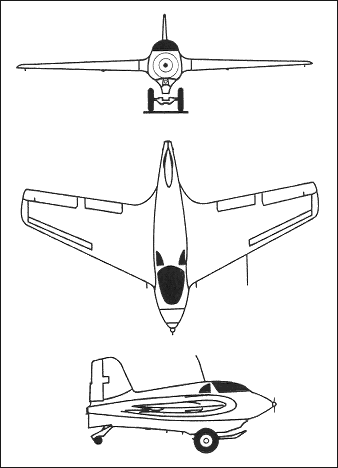The Messerschmitt Me 163 Komet (Comet) was a single-seat interceptor fighter that operated briefly at the end of Worl War 2, from 1944 to 1945. It was the fastest and one of the most radical aircraft of that war. History would tend to confirm that if the Messerschmitt Me 163 Komet had debuted a few years earlier, the Allied bombing campaign would have suffered even greater casualties in men and material than it actually did. And if the project for the Me 163 Komet had maybe gotten a little extra time put into it, I’m sure problems like an unstable fuel mixture would have been all but fixed, but time was a luxury the Germans did not have. The Messerschmitt Me 163 Komet was the most unique aircraft design of the Second World War. This rocket powered aircraft’s design was based on testing completed with an engine-less glider design. The resulting research produced the one-man, swept back fighter that was equally dangerous to pilot and Allied bomber formations alike.
Development
In 1930 engineers across the world had begun to perfect the rocket fuel engine. Starting in 1936, the Reichsluftfahrtministerium, or German Air Ministry, issued a series of contracts to the Hellmuth Walter Company to develop rockets for military uses. Walter’s work attracted the attention of Dr. Alexander Lippisch, Deutsches Forschunginstitut fär Segelflug , or the German Gliding Research Institute, who thought that early Walter rockets could be adapted to a tailless glider design. Lippisch got his wish, and was appointed head of Projekt X (not to be confused with Project X, the Matthew Broderick movie). The radical new design quickly took shape. The Idea of highly volatile fuels inside a highly flammable wood fuselage was thought maybe as a bad idea, requiring an all metal fuselage.(*cough*). The first six Messerschmitt Me 163-A prototypes entered trials in 1941, with the initial powered tests demonstrating speeds upwards of 550 mph (885 km/h) from conventional takeoff and 625 mph (1000 km/h) when first towed aloft. Unlike all aircraft of its day, the Me 163’s maximum speed was limited only by its maddeningly-high rates of fuel consumption. Design modifications made to help with fuel efficiency, as well as a new powerplant, led to the development of the Messerschmitt Me 163-B. The upgraded engine, the HWK 109-509A, used a less-volatile combination of fuels, but was fraught with developmental problems. The Me 163B, complete with its drop-away take-off dolly and retractable landing skid, didn’t begin powered trials until mid-1943.
 Performance
Performance
The production model of the Me163B didn’t reach the Luftwaffe until 1944, but when it did it was still a little buggy. Only one Me 163 unit, the I Gruppe of Jagdgeschwader 400, ever was brought to full strength due to shortages of war material (caused by Allied bombing campaigns) and skilled pilots. Of those planes that did get developed, were met with mixed results. Due to short range, many missions were aborted after they failed to find enemy planes. When combat did occur, it was usually too brief and lopsided; groups of a dozen Me163s strafing bomber formations of more than 1000 planes for three minute spates is not the best way to turn the tide of war. Komet pilots tallied a mere 9 kills for their efforts, losing 14 planes in return (about half of those during landing accidents).In all, 400 Messerschmitt Me 163 were built, but only 279 of those actually saw service. And a limited number of those built were of the Me 163S trainer variant.
Specifications
| Type: | Single-seat fighter/interceptor |
| Powerplant: | 1x Walter 109-509A-2 rocket motor generating 3,798lbs of thrust for 7.5 minutes of powered flight |
| Ceiling: | 29,698 ft |
| Range: | 50 miles |
| Weight(empty): | 4206 lb |
| Weight(loaded): | 9061 lb |
| Wingspan: | 30ft 6in |
| Length: | 19ft 4 in |
| Height: | 9ft 2in |
| Armament: | 2x 30mm cannons OR 2x 20mm cannons in wing roots. Experimental armament :2 x SG 500 Jagdfaust “Fighter Fist” vertically-firing tubes in wing roots (five tubes per assembly). Five 1.97 inch shells per tube. This system would replace the cannon configuration listed above if fitted. |
| Service: | 1944-1945 |

 Performance
Performance